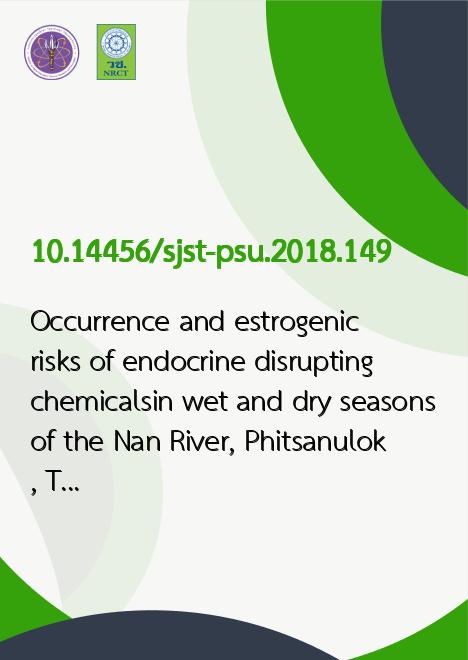
|
Occurrence and estrogenic risks of endocrine disrupting chemicalsin wet and dry seasons of the Nan River, Phitsanulok, Thailand |
|---|---|
| รหัสดีโอไอ | |
| Creator | 1. Saowanee Deemoon 2. Charoon Sarin 3. Kanokthip Juksu 4. Guang-GuoYing 5. Chanyud Kritsunankul 6. Sarin Sriprang |
| Title | Occurrence and estrogenic risks of endocrine disrupting chemicalsin wet and dry seasons of the Nan River, Phitsanulok, Thailand |
| Publisher | Research and Development Office, Prince of Songkla University |
| Publication Year | 2561 |
| Journal Title | Songklanakarin Journal of Science and Technology |
| Journal Vol. | 40 |
| Journal No. | 5 |
| Page no. | 1219-1227 |
| Keyword | estrogenic risks, EDCs, chemical analysis, bioassay, river |
| URL Website | http://rdo.psu.ac.th/sjstweb/index.php |
| ISSN | 0125-3395 |
| Abstract | The occurrence and estrogenic risks of endocrine disrupting chemicals (EDCs) in the Nan River, Phitsanulok wereinvestigated for the first time. EDCs (octylphenol;OP, nonylphenol;NP, bisphenol A;BPA, and estrone;E1) as well as estrogenicactivities (EEQs) were determined using gas chromatography-mass spectrometry (GC-MS) and Yeast Estrogen Screen (YES)bioassay. Concentrations of OP, NP, BPA, and E1in water, sediment, and fish were found up to 36.7, 1060, 1420, and 17.2 ng/L,2.8, 97.3, 13.2, and 12.4 ng/g, and 812, 663000, 339, and 11700 ng/g, respectively. Wet season, EEQs in water, sediment, and fishwere found with means of 0.36 ng/L, 0.1 ng/g, and 0.48 ng/g, respectively; while for dry season those were found with means of0.79 ng/L, 0.87 ng/g, and 0.35 ng/g, respectively. Results of this study showed that the Nan River was contaminated with EDCsand can be harmful to aquatic organisms with high estrogenic risk. |
